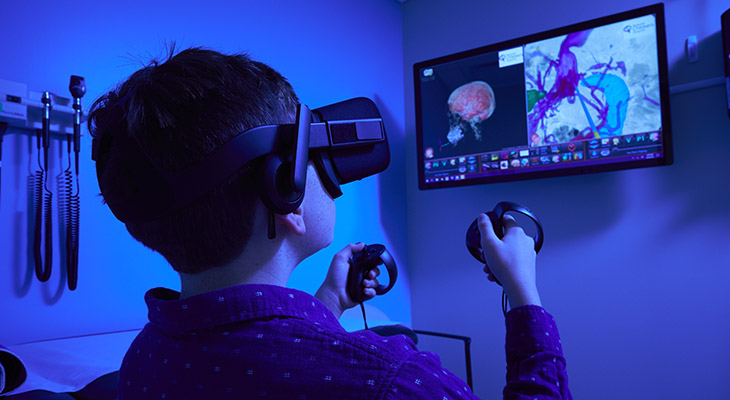
Norton Children’s Neurosurgery, a Part of Norton Neuroscience Institute, now has Surgical Theater virtual reality (VR) technology. It creates an immersive, 3D view of a patient’s brain. This allows neurosurgeons, patients and families to see inside the patient’s brain to get a greater understanding of the condition and any potential procedures. Norton Children’s Hospital is the first hospital in the region to use this technology.
How Surgical Theater Works
Surgical Theater gives neurosurgeons an interactive way to experience the brain. Surgical Theater converts black-and-white, 2D radiological images into a 360-degree, color, virtual reality model of a patient’s brain. From there, physicians can use a VR headset and video-game-like controller to explore every part of the patient’s brain.
The operating room portion of Surgical Theater offers the same technology for neurosurgeons during a procedure. This makes it possible for the surgeon to see his or her tools in real time and navigate them through the surgery as planned.
Children’s Hospital Foundation making virtual reality, a reality
Surgical Theater was made possible through the Children’s Hospital Foundation with support from the community, WHAS Crusade for Children and Texas Roadhouse. The foundation is working to raise additional funds to fully implement the technology.
Making Complex Technology Accessible for Patients
Surgical Theater takes the technology and laborious work of multidisciplinary teams at large medical research centers and makes it readily available at a much quicker pace. Surgical Theater is able to render these models within a few hours for a case that requires several scans.
This technology allows neurosurgeons and other physicians to:
- Integrate many scans at once. This technology allows physicians to view all of a patient’s radiological imaging together, and makes it possible to see important relationships easily. This gives physicians an ability to understand complicated neurosurgical problems quickly.
- Plan and practice procedures. The technology allows surgeons to plan and practice surgery with ease. Surgeons can use the joystick to plan a procedure, including instrument choice, and practice the procedure within the VR. Physicians can practice different approaches to choose the safest option possible. This model can show more easily all the information surgeons need to do a safe surgery.
- Choose the right treatment plan. The model can help physicians collaborate and create care plans for complex cases. Surgical Theater can prompt discussions about the best treatment options without surprises in the operating room.
- Perform better patient education. Patients and families can better understand the condition and the affected parts of the brain. It also allows physicians the opportunity to demonstrate a procedure and how it will be done in the operating room. This can help patients and families make informed decisions based on the risks and benefits.
“This is revolutionizing how we use our information to decide how to treat patients,” said Ian S. Mutchnick, M.D., pediatric neurosurgeon with Norton Children’s Neurosurgery, a Part of Norton Neuroscience Institute..

